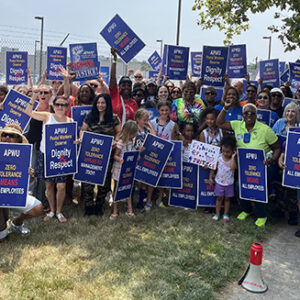March 1, 2016
Cleveland Gets Proactive with Safety
(This article first appeared in the March-April 2016 issue of The American Postal Worker magazine.)
The Cleveland Area Local is ramping up its safety campaign, taking a proactive stance when dealing with unsafe working conditions.
Local President Daleo Freeman explained that although the local’s safety committee was formed several years ago, it has gotten “more robust” in recent months. The local hopes to improve its effectiveness by getting more members involved – especially younger members. As an incentive, the most proactive safety committee member will be rewarded with the use of a union parking spot for one month.
“If the members are not active with it, then it won’t be successful,” Freeman said of the campaign. “We are trying to do something new and are glad the national is taking up the charge… We will do our part.”
These are the kinds of activities the national Stand Up for Safe Jobs campaign is intended to encourage.
The local’s safety committee conducts its own safety inspections before those conducted by the Labor-Management Safety Committee, and reports the hazards it uncovers to management.
In January the committee identified violations such as emergency lights that need to be repaired or replaced; exit signs that need to be repaired or replaced; Powered Industrial Trucks (PITs) being operated without strobe lights; faulty or inaudible Medical Emergency Response Team (MERT) public announcement system; supervisors lacking knowledge and/or ability to complete accident reports and associated paperwork; driving too fast on the workroom floor, and dirty restrooms. Management promised to correct the hazards, Freeman said, “but the proof is in the pudding.”
“These are potential hazards that can affect anyone at any particular time,” Freeman said. “You definitely want to go home the way you came.”
Fire Safety and Prevention Fact Sheet
As part of the APWU’s campaign to Stand Up for Safe Jobs, locals across the country have been distributing fact sheets outlining our right to a safe workplace. Fact Sheet #4, Fire Safety and Prevention, is the latest to be released. The fact sheets are available at www.apwu.org/issues/safe-jobs.
According to the Employee and Labor Relations Manual (ELM), installation heads are responsible for implementing emergency action plans and fire safety programs.
How does your workplace measure up?
- Are exits clear and properly maintained?
- Do you know the location of fire alarms? Are they tested regularly?
- Do you know the location of fire extinguishers? Are they inspected regularly?
- Is there a fire extinguisher within 50 feet?
- Are postal vehicles stocked with fire extinguishers and emergency warning kits?
- Is there an Emergency Evacuation Team (EET) on your tour? Are the names posted? Are alternates assigned to cover absences?
- Does your office conduct at least one emergency evacuation drill on your tour each year?
- Are evacuations quick and orderly?
- Do you know how injured employees and people with disabilities are supposed to be evacuated?
- Does management conduct regular fire inspections?
- Do you know the fire prevention plan for your area? Is it reviewed with you annually?
- Do you know emergency escape procedures?
- Have you seen your facility’s written emergency plan? (In facilities of fewer than 10 employees the plan may be communicated verbally.)
If the answer to any of the above is “no,” talk to your co-workers and stand together for safe workplaces:
- Raise your concerns at Safety Talks.
- Fill out PS Form 1767, Report of Unsafe Conditions.
- Request to see your shop steward.
- Call OSHA if violations pose a risk of serious harm (1-800-321-OSHA).
- Follow up with management until unsafe conditions are corrected.
Everyone has the right to leave work in one piece.



